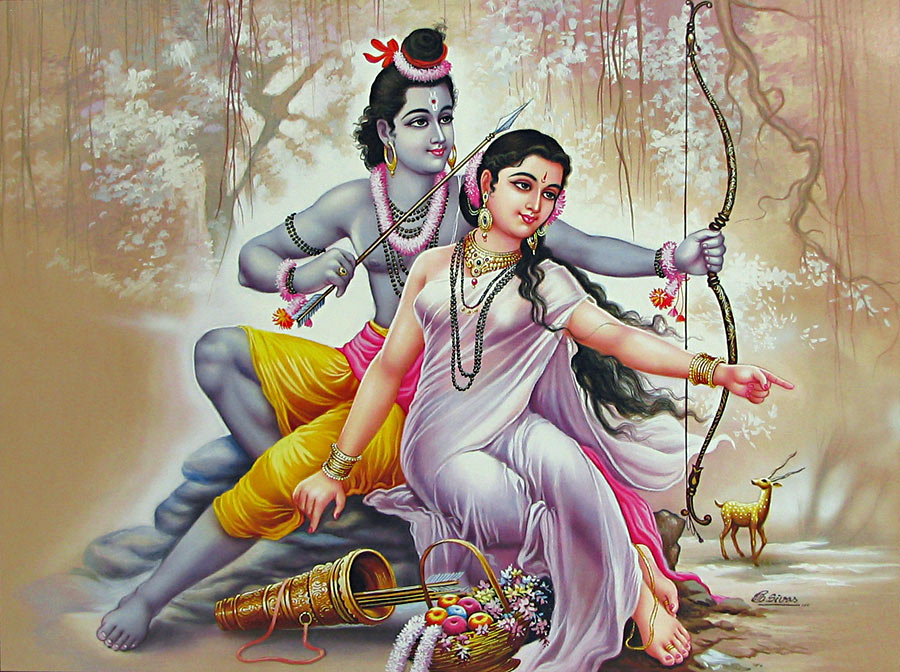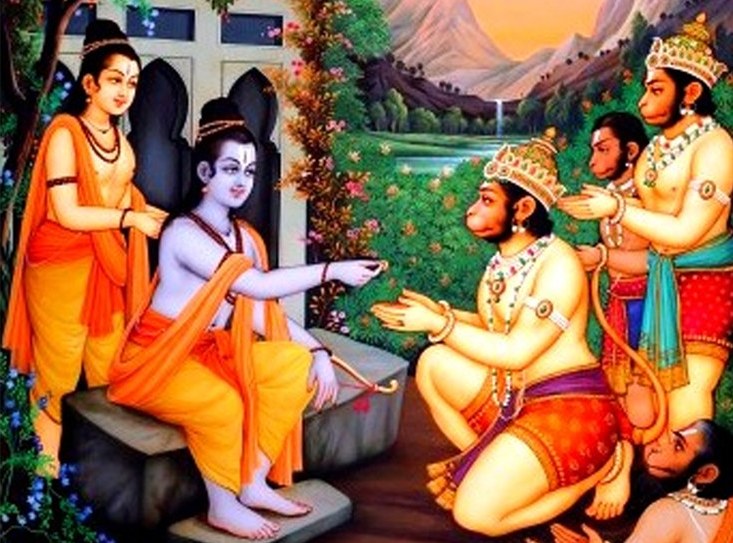Ramayana is a holy river of wisdom which descended from a mountain of knowledge called
Valmiki. By portraying the duties of relationships, by describing the aspect of idealness
and by exploring human values and dharma, Ramayana has registered itself in the hearts of
people as the ambassador of the rich and glorious history of this Nation. The word Ramayana
is the 'Tat Purusha' compound of the word 'Rama' and 'Ayana' which translates to 'going' and
'advancing'. Every word in this epic echoes the righteousness of the reliever of suffering,
the destroyer of evil, the bestower of all riches, the soul of the epic, Lord Sree Rama.
Incidentally the first letter of every 1000 verses (total 24) make the make the Gayatri
mantra.
Hailing from the Surya Clan of rulers founded by the son of Manu named Ikshvaku, Rama was
the 40th emperor of the mighty Ayodhya dynasty.
Verses in the Ramayana are written in a 32-syllable meter called anustubh. The Ramayana was
an important influence on later Sanskrit poetry and Hindu life and culture. Like the
Mahabharata, the Ramayana is not just a story: it presents the teachings of ancient Hindu
sages in narrative allegory, interspersing philosophical and devotional elements.
The Classical music of India is a celestial and a spiritual path to express one bhakthi
towards the almighty. Having its origin from Sama Veda, the classical music of India has
played a significant role in preserving, promoting and protecting great cultural heritage of
the nation. Indian classical music is both elaborate and expressive. It divides the octave
into 12 semitones of which the 7 basic notes are, in ascending tonal order, and Sa Ri Ga Ma
Pa Dha Ni. However, Indian music uses just intonation tuning, unlike most modern Western
classical music, which uses the equal temperament tuning system. Also, unlike modern Western
classical music, Indian classical music places great emphasis on improvisation.
Music was a part of social fabric of the society as described in Ramayana. Ramayana is more
closely associated with music than any other epic. That might be because Ramayana is
rendered in verse; and, its poetry of abiding beauty melts into music like molten gold, with
grace and felicity. Further, the epic has a certain lyrical luster to it. The epic itself
mentions that the Rama tale was rendered in song by Kusha Lava(I.20.10).
The Ramayana had its origins in folk lore; and was preserved and spread as an oral epic, for
a very longtime. It is suggested that poet Vamiki rendered the folk lore into a very
beautiful, sensitive and lyrical epic poem by about 7th century BCE. Thereafter, in age
after age, the suthas narrated and sang the glory of Rama and Sita, in divine fervor; and
spread the epic to all corners of the land and even beyond. Even to this day , the tradition
of devote groups of listeners gathering around a sutha to listen to the ancient story of
chaste love between Rama and his beloved, and their unwavering adherence to Dharma amidst
their trials and tribulations; is still very alive.
What characterize the Dharma in Ramayana are its innocence, purity and nobility. The Indian
people prefer listening with joy, the rendering of Ramayana as musical discourse, to reading
the epic themselves.
There are innumerable references to music in Ramayana. Music was played for entertainment
and in celebration at the weddings and other auspicious occasions; (II.7.416-36; 48.41.69;
III.3, 17; 6.8; IV 38.13; V.53.17; VI.11.9; 24.3; 75.21 etc.). Music was also played in
palaces and liquor parlors (IV 33.21; V.6.12; X.32; 37.11.4; Vi.10.4). Soulful songs were
sung to the accompaniment of instruments, at religious services and in dramas. The warriors
fighting on the battlefield were lustily cheered and enthused by stout drum beats; and
piercing blow of conches, horns and trumpets. There is also mention of those who took to
music as a profession. Besides, there were court (state) sponsored musicians.
Sundara Kanda mentions that Ravana was fond of music; and music was played in his palace.
He, in fact, suggests to Sita, she could relax a bit listening to music in his palace,
instead sitting tensely under the tree. It is said Ravana was a well known player of veena
(an instrument played with a bow).He compared the battlefield to a music stage; bow (weapon
for firing arrows) to his veena; arrow to his musical bow; and the tumultuous noise of the
battle to music (VI: 24:43-44).
As mentioned, the music in Valmiki's Ramayana was sung and played for entertainment; it was
performed amidst public in celebrations; and it was used by minstrels to sing ballads. The
concept of linking music to spiritual development did not appear to be present, then.
The later texts, say of 4th to 6th century AD, such as Brihaddeshi, Vayupurana and Narada
shiksha assigned the musical taanas, names of the various Yajnas; and said that the benefits
of those yajnas could be obtained by singing the relative taanas. The Yajnavalkhya shiksha
said, the music would help spiritual practices. The idea that music was a way to liberation
(moksha sadhana) seems to have emerged at a later stage, perhaps during the Bhakthi period
(10th -11th century and onwards).]
The music was both vocal and instrumental. The musical instruments, of the time, were
categorized, broadly, as those played by hand (hastha_vadya); and as those played by mouth
(mukha -vadya) (II.65.2). The string and percussion instruments came under the former
category; while the wind instruments were among the latter category. It appears instruments
were used mainly as accompaniments, and depended on vocal music. Group music- vocal with
instruments –appeared to be popular.
Valmiki mentions that Kusha - Lava were well aware of murchhanas [2] and sthanas; and they
also maintained the right laya yathis. He also mentions, their singing was Baddha- well
structured- with apt rhythm, tempo and words (I.4.8).Valmiki also says, Kusi- Lava sang in
marga tradition (I.4.35); and they employed seven jatis (I.4.8).As regards the words in the
lyrics, Valmiki endorses use of sweet sounding words, with simple and light syllables; and
advises against harsh words loaded with heavy syllables (IV.33.21). From these statements,
one can try inferring the state of music in Vamiki's time.
Since Valmiki mentions that Kusha & Lava sang in the marga tradition (I.4.35), we can infer
that the distinction between marga and desi systems was in place by then. That is
significant. Marga system is highly regarded as the music fit for gods and gandharvas [3].
It is said to have been derived from Sama Veda; and constituted of pada (the textual part of
a musical composition as contrasted with the melodic and rhythmic aspects), svara (notes)
and tala (rhythm).Marga is rather somber and not quite flexible too. The desi system [4], on
the other hand, derives its inspiration from the folk tradition, adopts itself to the
changing demands of the times, is more innovative and is sung mainly for entertainment [5].
Valmiki suggests that Kusi Lava rendered Ramayana in the pristine music form.
Valmiki says the music of Kusha & Lava was baddha, structured into stanzas with laya
(rhythm) and tala (beats or rhythmic counter point); just as the kritis and pallavis of the
present-day. The music at those times was well ordered and neatly presented in gitas – words
set to music and rhythym. Its contrasting style was anibaddha, unstructured and without
rhythm; analogous to the present-day aalap, ragamalika, slokas etc. The baddha – anibaddha
distinction is observed even today, just as in Valmiki's time.
It is said that Kusha & Lava sang in seven jatis, and they were shuddha (pure) jati. That
signifies the distinction between the shuddha (pure) and sankara (mixed) jatis was in
existence even during Valmiki's time. Jati refers to the classification of musical
compositions as per the tones. It means Kusi Lava rendered the verses in several melodies.
However, since the raga concept was, then, yet to be evolved, there might not have been much
depth and variation in their rendering. Since jatis were mentioned, it can be assumed that
the two fundamental tonal systems shadja-grama and Madhya-grama [6] were also well known.
Valmiki mentions, Kusha & Lava were familiar with murchana and sthana ; as also with the
rhythmic patterns –laya, yati – in three-speeds.
Even with its limitations, Valmiki accorded much importance to music and elements of music
in his work. He crafted situations where music could be introduced naturally. More
importantly, his verses have a very high lyrical quality and can be rendered in to music
quite easily. All these speak of Valmiki's love for music and his aesthetic refinement.
It is not therefore surprising that Abhinavgupta (ca.11th century) hailed Valmiki as Rasa
Rishi one who created an almost perfect epic poem adorned with the poetic virtues of Rasa,
soundarya (beauty of poetic imagery) and vishadya (lucid expression and comfortable
communication with the reader); all charged and brought to life by prathibha , the ever
fresh intuition.






















